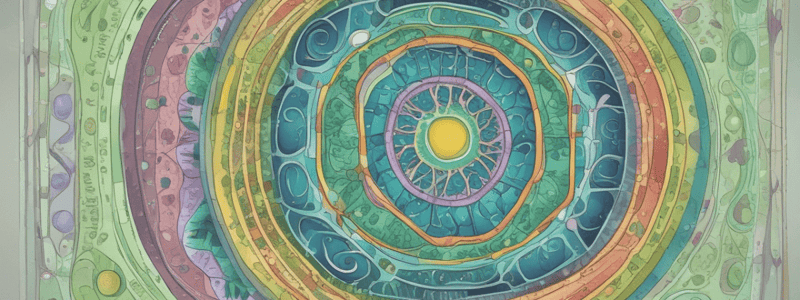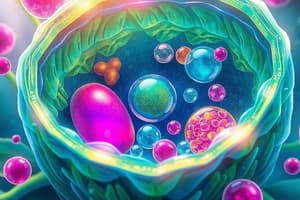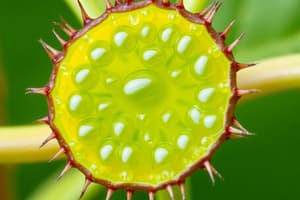Podcast
Questions and Answers
What is the primary function of vacuoles in plant cells?
What is the primary function of vacuoles in plant cells?
- To maintain proper levels of water within plants (correct)
- To synthesize proteins
- To regulate turgor pressure within plants
- To remove waste products
What is the main component of plant cell walls?
What is the main component of plant cell walls?
- Proteins
- Nucleic acids
- Cellulose and other polysaccharides (correct)
- Lipids
What is the function of turgor pressure in plants?
What is the function of turgor pressure in plants?
- To regulate protein synthesis
- To maintain proper levels of water within plants
- To eliminate waste products
- To help plants keep their shape and regulate water balance (correct)
How do plant vacuoles differ from animal vacuoles?
How do plant vacuoles differ from animal vacuoles?
What is the main distinction between plant cells and animal cells?
What is the main distinction between plant cells and animal cells?
What process causes water to enter the central vacuole of a plant cell?
What process causes water to enter the central vacuole of a plant cell?
What happens to the plant cell placed in an isotonic environment?
What happens to the plant cell placed in an isotonic environment?
In a hypertonic solution, plant cells lose water due to:
In a hypertonic solution, plant cells lose water due to:
What is the main function of turgor pressure in plant cells?
What is the main function of turgor pressure in plant cells?
What happens to a plant cell in a hypotonic environment?
What happens to a plant cell in a hypotonic environment?
What is the main function of the central vacuole in a plant cell?
What is the main function of the central vacuole in a plant cell?
Which organelle in animal cells is functionally similar to the central vacuole in plant cells?
Which organelle in animal cells is functionally similar to the central vacuole in plant cells?
What does the middle lamella in a plant cell wall primarily consist of?
What does the middle lamella in a plant cell wall primarily consist of?
In the absence of a rigid cell wall composed of cellulose, what would happen to plant cells?
In the absence of a rigid cell wall composed of cellulose, what would happen to plant cells?
What differentiates animal vacuoles from plant central vacuoles?
What differentiates animal vacuoles from plant central vacuoles?
Flashcards are hidden until you start studying
Study Notes
Plant Cell Vacuoles & Cell Wall
- Eukaryotic cells have a nucleus and membrane-bound organelles, distinguishing them from prokaryotic cells.
- Plant cells are a specialized type of eukaryotic cells.
- Plant cells have two distinguishing structures: large vacuoles and cell walls.
- Vacuoles are membrane-bound organelles found in both plant and animal cells.
- Plant vacuoles are larger than animal vacuoles and have various functions like storage, growth, and waste elimination.
- Many plant cells have a single large central vacuole, while animal cells have smaller lysosome-type vacuoles involved in waste elimination.
- The central vacuole in plant cells can represent up to 90% of the cell's inner space and maintains turgor pressure.
- The central vacuole has a tonoplast membrane that regulates water flow and contains cell sap with water, enzymes, ions, and other molecules.
- The primary role of the central vacuole is to maintain turgor pressure, shape the cell, and store water, nutrients, and waste.
- The cell wall, made of cellulose and other polysaccharides, provides strength and flexibility to plant tissues and works with vacuoles to maintain turgor pressure.
- Plant cell walls have three layers: primary cell wall, secondary cell wall, and middle lamella.
- The primary cell wall is strong and flexible, and the secondary cell wall is more fibrous and protects against damage.
- The middle lamella contains pectin and helps hold plant cells together.
- The cell wall's main functions include maintaining cell shape, regulating water content, facilitating communication between cells, protecting against pathogens and insects, and storing energy for growth.
- The cell wall and central vacuole work together through osmosis to maintain turgor pressure.
- Osmosis causes water to enter the central vacuole, increasing internal water pressure and pushing the cell membrane against the cell wall.
- This turgor pressure helps the plant cell maintain its shape.
- In a hypotonic environment, the plant cell maintains its shape due to turgor pressure, while in an isotonic environment, the cell becomes soft and flaccid.
- In a hypertonic solution, the plant cell loses water and wilts, despite the cell wall maintaining its shape.
Studying That Suits You
Use AI to generate personalized quizzes and flashcards to suit your learning preferences.




